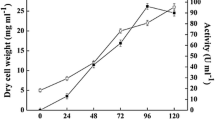Abstract
An intracellular S-adenosylmethionine synthetase (SAM-s) was purified from the fermentation broth of Pichia pastoris GS115 by a sequence chromatography column. It was purified to apparent homogeneity by (NH4)2SO4 fractionation (30–60%), anion exchange, hydrophobic interaction, anion exchange and gel filtration chromatography. HPLC showed the purity of purified SAM-s was 91.2%. The enzyme was purified up to 49.5-fold with a final yield of 20.3%. The molecular weight of the homogeneous enzyme was 43.6 KDa, as determined by electro-spray ionization mass spectrometry (ESI-MS). Its isoelectric point was approximately 4.7, indicating an acidic character. The optimum pH and temperature for the enzyme reaction were 8.5 and 35 °C, respectively. The enzyme was stable at pH 7.0–9.0 and was easy to inactivate in acid solution (pH ≤ 5.0). The temperature stability was up to 45 °C. Metal ions, such as, Mn2+ and K+ at the concentration of 5 mM had a slight activation effect on the enzyme activity and the Mg2+ activated the enzyme significantly. The enzyme activity was strongly inhibited by heavy metal ions (Cu2+ and Ag2+) and EDTA. The purified enzyme from the transformed Pichia pastoris synthesized S-adenosylmethionine (SAM) from ATP and l-methionine in vitro with a K m of 120 and 330 μM and V max of 8.1 and 23.2 μmol/mg/min for l-methionine and ATP, respectively.






Similar content being viewed by others
References
Berger BJ, Knodel MH (2003) Characterisation of methionine adenosyltransferase from Mycobacterium smegmatis and M. tuberculosis. BMC Microbio 3:12
Bradford MM (1976) A rapid and sensitive method for the quantitation of microgram quantities of protein utilizing the principle of protein-dye binding. Anal Biochem 72:248–254
Cabrero C, Puerta J, Alemany S (1987) Purification and comparison of two forms of S-adenosylmethionine synthetase from rat liver. FEBS 170:299–304
Cereghion JL, Cregg JM (2000) Heterologous protein expression in the methylotrophic yeast Pichia pastoris. FEMS Microbiol Rev 24:45–66
Chen XL, Wang YS, Zhen YG (2006) Study on the extraction and purification of S-adenosylmethionine synthetase (Chinese). Biotechnol 15(1):61–63
Chiang PK, Cantoni GL (1977) Activition of methionine for transmethylation. purification of the S-adenosylmethionine synthetase of Bakers’ yeast and its separation into two forms. J Biol Chem 252(13):4506–4513
Chiang PK, Gordon RK, Zeng GC, Doctor BP, Pardhasaradhi K, (1996) S-Adenosylmethionine and methylation. FASEB J 10:471–480
Chou TC, Talalay P (1972) The mechanism of S-adenosylmethionine synthesis by purified preparations of Baker’s yeast. Biochem 11:1065–1073
Cui W, Huang L, Li W (2006) Cloning and expression of rat liver S-adenosylmethionine synthetase. Chem Res Chinese 22:236–238
Li DY, Yu J, Tian L, Ji XS, Yuan ZY, (2002) Production of SAM by recombinant Pichia pastoris. Chin J Biotechnol 3:295–299
López-Vara MC, Gasset M, Pajares MA (2000) Refolding and characterization of rat liver methionine adenosyltransferase from Escherichia coli inclusion bodies. Protein Expr Purif 19:219–226
Markham CD, Hafner EW, Tabor CW, Tabor H, (1980) Adenosylmethionine synthetase: supplemental material to S-adenosylmethionine synthetase from Escherichia coli. J Biol Chem 255:982–9092
Markham GD (1981) Spatial proximity of two divalent metal ions at the active site of S-adenosylmethionine synthetase. J Biol Chem 256:1903–1909
Mathur M, Sachar RC (1991) Phytohormonal regulation of S-adenosylmethionine synthetase and S-adenosylmethionine levels in dwarf pea epicotyls. FEBS 287:113–117
Mcqueney MS, Markham GD (1995) Investigation of monovalent cation activation of S-adenosylmethionine synthetase using mutagenesis and uranyl inhibition. J Biol Chem 270:18277–18284
Mincheva K, Kamburova V, Balutzov V (2002) Production of S-adenosyl-lmethionine by a mutant strain of Kluyveromyces lactis. Biotechnol Lett 24:985–988
Mitsui K, Teraoka I, Tsukada K (1988) Complete purification and immunochemical analysis of S-adenosylmethionine synthetase from bovine brain. J Biol Chem 263:11211–11216
Ochi K (1987) Metabolic initiation of differentiation and secondary metabolism by Streptomyces griseus: significance of the stringent response (ppGpp) and GTP content in relation to A factor. J Bacteriol 169:3608–3616
Okada G, Teraoka H, Tsukada K (1981) Multiple species of mammalian S-adenosylmethionine synthetase: partial purification and characterization. Biochem 20:934–940
Omura S, Ikeda H, Ishikawa J (2001) Genome sequence of an industrial microorganism Streptomyces avermitilis: deducing the ability of producing secondary metabolites. Proc Natl Acad Sci USA 98:12215–2220
Patrick SM, Fazenda ML, Mcneil B, Harvey LM (2005) Heterologous protein production using Pichia pastoris expression system. Yeast 22:249–270
Schroder G, Eichel J, Breinig S, Schroder J (1997) Three differentially expressed S-adenosylmethionine synthetases from Catharanthus roseus: molecular and functional characterization. Plant Mol Biol 33:211–22
Shiomi N, Fukuda H, Fukuda Y, Schroder J (1990) Production of S-adenosyl-l-methionine by Saccharomyces cerevisiae cells carrying a gene for ethionine resistance. Biotechnol Bioeng 35:1120–1124
Yoon GS, Ko KH, Kang HW, Suh J, Kim GS, Ryu YW (2006) Characterization of S-adenosylmethionine synthetase from Streptomyces avermitilis NRRL 8165 and its effect on antibiotic production. Enzyme Microb Technol 39:466–473
Acknowledgements
We are grateful to National High Technology Research and Development Program of China (863 Program) (No. 2002aa217021; 2002aa2z3451) for its financial support. We are also indebted to Dr. Xiao-Qing Hu for some advice during the course of this work.
Author information
Authors and Affiliations
Corresponding author
Rights and permissions
About this article
Cite this article
Zhou, J., Chu, J., Wang, YH. et al. Purification and properties of Saccharomyces cerevisiae S-adenosylmethionine synthetase expressed in recombinant Pichia pastoris . World J Microbiol Biotechnol 24, 789–796 (2008). https://doi.org/10.1007/s11274-007-9538-9
Received:
Accepted:
Published:
Issue Date:
DOI: https://doi.org/10.1007/s11274-007-9538-9




